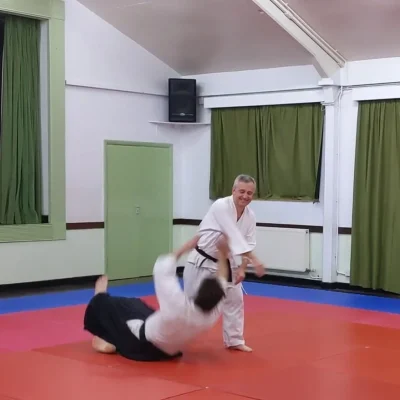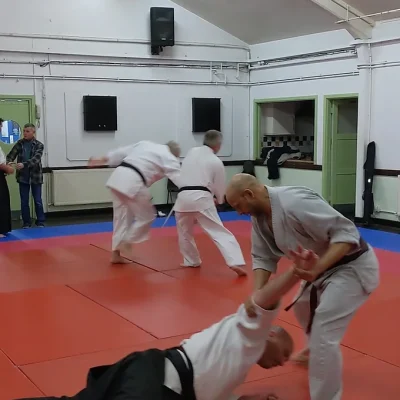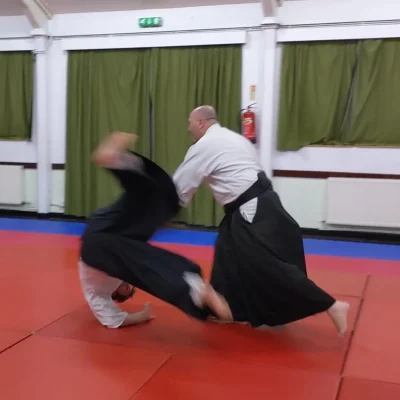DOJO ETIQUETTE
AN ESSENTIAL PART OF OUR CLUB
Etiquette is essential for the proper study of any martial art and without it our efforts become meaningless. Self-discipline, mutual trust and respect for instructors and fellow students are essential for safe practice and development. In Bugeisha Aikido we believe that true and sincere etiquette (i.e. how you conduct yourself) is the ultimate form of self-defence. By this we mean that the way you conduct yourself off the mat is an expression of who you are and this is in turn a measure of your development on the mat.
PERSONAL CONDUCT
The following outlines our club rules around personal conduct. They are not onerous, but they are an essential part of how we interact in the dojo.
All club members are asked to put the mats down prior to the start of the session and to put them away at the end of the session. If someone is running late or has to leave early, then that’s life and totally understandable. The aspiration of all club members should always be to arrive in time to put down the mats and allow enough time to put them away before leaving.
Always strive to be on the mat and ready to commence training before the instructor starts the class. This for several reasons. Firstly, as a sign of respect for the instructor and your fellow students. Secondly, it ensures that you warm up sufficiently to participate fully and safely in the class. Finally, timing and commitment are an important part of the discipline of training.
Note: There are times when we are all late to a class, that’s life and that’s fine. We would always rather that everyone comes and trains even if they are going to be late. All we ask is that anyone who knows that they will not make the class or that they will be late, lets the club know. The best way to do this is through the WhatsApp group which every club member is made a part of upon joining.
Never walk on the mats with footwear. This is to preserve the mats but perhaps more importantly it shows respect for the training area.
Once a session has started do not step on or off the mat until invited to do so by the instructor. This is both for obvious safety reasons and the fact that any given technique is part of the theme of the class being present by the instructor. Which includes the dynamics of the training at any given time and perhaps more importantly, the students welfare. Therefore, the instructor needs to know who is present on the mat at all times and if there is a situation that needs to be addressed.
No one is compelled to do or receive a technique if they do not feel safe or able to do it. If this should occur the instructor will adjust accordingly. If a student is willing to participate then they must immediately follow the instructions of the instructor and only do the technique or activity shown. This is for obvious safety reasons and any given technique is part of the flow of the class.
Students are required to –
- Always treat the dojo with respect.
- Ensure that they have good hygiene and that their dogi is clean.
- Respect their fellow students both in person and their belongings.
- Before and after training humour is encouraged but never at the expense of others.
- At the end of every class, in addition to the closing bows and before leaving the mat, all those participating in the class shake hands with their fellow class members. The purpose of this to thank everyone who has trained individually for being there and being part of each other’s learning experience.
Bow upon stepping into and leaving the dojo. This is for two main reasons. Firstly, it demonstrates respect to the instructor and fellow students. Secondly, when entering it starts to prepare you for the training to come and when leaving it signifies that your training has ended
BOWING
Bowing is not a common western form etiquette outside of formal occasions or certain religious ceremonies, so the following is a brief explanation as to why we bow in the dojo.
Starting and ending a class by bowing is purely a tribute to the Japanese origins of the art. We do not have a kamiza (shrine) in the dojo due to the fact that we embrace all cultures without focussing exclusively on a Japanese worldview. As the name of our club implies, we are seeking truths through the study of Aikido, we are not seeking to emulate another culture. Therefore, with the exception of a few commands, which you will quickly learn, such as ‘rei’ (bow) and ‘yame’ (stop) and the names of techniques and attacks, in our club no other Japanese is required. We keep these phrases mainly because it is useful to know them if you ever decide to visit or train in any other dojo which promotes the use of Japanese terminology.
We bow on four occasions –
- When entering the dojo as a symbol of the transition from the outside world with all it’s cares to the focused study contained within the dojo.
- When leaving the dojo as a symbol that the study session has ended and we are now ready to re-engage with the outside world.
- Twice at the beginning and end of a training session. The first bow is a collective acknowledgement of the joy of training together. The second bow is the instructor thanking the students for attending and the students thanking the instructor for teaching them.
- Twice at the beginning and end of a grading. The first bow is to acknowledge the instructor and the second bow is the students acknowledging their willingness to fulfil their roles in the grading.
UKEMI
Without Ukemi there is no proper study of Aikido. It’s so important that there has to be a consistent approach to it both for the person doing the throw or lock (Nage) and the person receiving the throw or lock (Uke). The following outlines our club rules around Ukemi.
Instructors should always thank the Uke after each demonstration and give feedback on the quality of the Ukemi.
It should always be remembered by the Uke that it is a privilege to be chosen for this role as it demonstrates trust from the instructor and it is an opportunity to feel the technique first-hand.
Students will only apply the technique and associated Ukemi being practiced. Any modifications with be solely under the direction of the instructor and agreed with the students prior to participating.
Anyone taking Ukemi is responsible for their own health and safety. This means that if they do not think they are well enough, or for whatever reason they do not feel physically capable of receiving the technique being studied, then they have a duty to declare this. Once declared, under no circumstances will the technique being studied be practiced with them during that class. Modifications to the technique in question or a different technique that the individual can safely receive can be agreed with the instructor and the students involved.
DRESS CODE
The following outlines our club rules around the dress code
To ensure the safety of all who train jewellery cannot be worn during training. The exception to this is smooth surfaced wedding bands which cannot be removed easily. Jewellery can be easily damaged during training and more importantly jewellery can cause unnecessary injuries.
Always make sure that you train in a clean white dogi. Hygiene is extremely important in any activity involving physical exertion.
Your dogi must be correctly worn at all times.
Always make sure that you train in a clean dogi as hygiene is extremely important in any activity involving physical exertion.
In Bugeisha Aikido we do not have strict dress codes with regard to the type of dogi to be worn. However, this is a Japanese martial art and to maintain the spirit of the art only white judo, karate, aikido dogis may be worn.
The only exception to the above is a Taekwondo dogi which may be worn by women in instances where they do not feel comfortable wearing one of the previous three types of dogi. All women are to wear a white t-shirt under their dogi, unless they are wearing a taekwondo style top.
Within a month of becoming a member of the club anyone training is required to wear a serviceable dogi as described above. If required, club members can provide guidance on how and where to buy a good dogi.
The only exception to the above is a Taekwondo dogi which may be worn by women in instances where they do not feel comfortable wearing one of the previous three types of gi. All women are to wear a white t-shirt under their dogi, unless they are wearing a taekwondo style top.
Within a month of becoming a member of the club anyone training is required to wear a sevicable dogi as described above.
So that the those participating in the training are aware of the capability of those they are training with, anyone on the mat must wear the colour belt that they have awarded by or has been recognised by the club.
For safety reasons belts must be tied correctly at all times while training.
The hakama is one of the symbols of an Aikidoka and it adds a dimension to the training which all dan grades need to be aware of and owning one is compulsory.
Wearing a hakama is encouraged for all grades but owning one is a choice for kyu-grades.
If required, club members can provide guidance on how and where to buy a good hakama.
PERSONAL CONDUCT
The following outlines our club rules around Personal Conduct
Since we train in close proximity with each other personal hygiene is of utmost importance. This includes short, clean finger and toe nails.
Anyone with long hair must make sure that it is tied back.
Unless for specific learning purposes set by the instructor, no language that could cause embarrassment or offence is to be used in the dojo.
There will be no changing of clothes in the dojo where this could cause embarrassment or offence.
All club members will treat visitors to the dojo with the respect and good manners that anyone would expect if they were a visitor.
Upon joining and to be considered a club member, all members must have completed and returned a membership form and have set up a standing order to pay the monthly membership fee promptly.
All members must hold valid insurance to be able to train and all instructors must hold a current public liability insurance certificate. These are covered by the monthly fee and are sourced by the club.
It is the member’s responsibility to report any injuries or illnesses (permanent or temporary) to the instructor prior to commencing any training session.
Weapons
The following outlines our club rules around the use of weapons
Unless specified by the instructor for specific training purposes, all weapons used on the mat will be wooden.
An exception to this will be rubber tantos where the nature of the training may require an addition level of safety which these items bring.
The primary weapons studied in Bugeisha Aikido are the bokken, jo and tanto and each club member is encouraged to purchase their own set from a reputable source to the standard of quality, construction and design accepted by the club.
Prior to bringing any wooden weapons onto the mat the quality, construction and design must first be agreed by the instructor who has the right to refuse their use in the class.
The instructor may introduce other weapons for specific training purposes; however, it is incumbent on the instructor to provide a sufficient amount for the intended lesson and students are not required to purchase these.
Maintaining Etiquette
The following outlines our club rules around Maintaining Etiquette
By joining the club all members have agreed to abide by the etiquette outlined above, to maintain the spirit of the club and the safety of all who train.
Disregard for the safety of others or failure to comply with any reasonable request from the instructor will not be tolerated and will result in the person being asked to leave the dojo.
Any breach will be addressed by the Chief Instructor.
Any complaints should be made directly to the Chief Instructor.
In all matters the decision of the Chief Instructor is final.
Just 3 reasons to join us
WHY JOIN BUGEISHA AIKIDO CLUB?
DEFENSE
Initially you will learn how to defend yourself if you need to and to do this by causing the minimum damage to your attacker necessary to preserve yourself. As you progress in your studies you will develop the ability to not only defend yourself but also to preserve your friends, family and if necessary, those who cannot defend themselves. The ultimate goal of Aikido is to develop your ability to where, if the situation allows, you are capable of neutralising and preserving the attacker.
community
The word community can be defined as ‘the condition of sharing or having certain attitudes and interests in common’. First and foremost, our desire is that you will quickly realise that you are joining a welcoming, supportive, and friendly group of people. A group of people drawn from all walks of life, both male and female and a wide range of ages. What unites us is a shared passion for studying the martial art and a desire to grow in our understanding together.
WELLBEING
Joining Bugeisha Aikido Club and studying Aikido offers a holistic approach to well-being everyone can benefit from. This happens through a blend of physical fitness, increased clarity around conflict, enhanced confidence, and a deeper understanding of your body’s capabilities.
ENJOYABLE
There is no question that studying a martial art can be frustrating at times and for most people it does not come easy. But if something isn’t challenging then perhaps it’s not worth studying. We firmly believe that the rewards from studying Aikido are numerous and well worth the sacrifice in time and effort to train. A few rewards to consider are the joy of mastering new skills, the fun of training together with like-minded people, and the satisfaction gained from finding your way of doing the techniques taking into account your experience and capabilities.
A few kind words
What our members say


